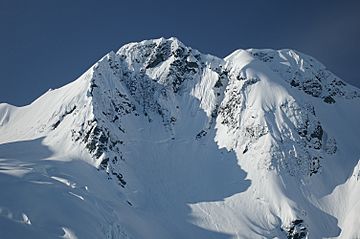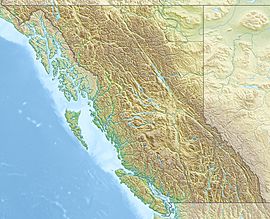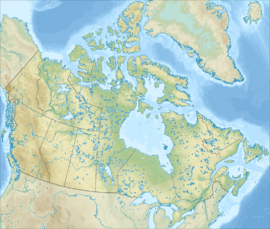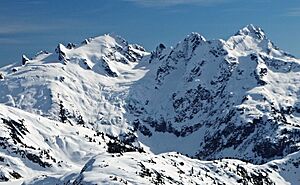Ossa Mountain facts for kids
Quick facts for kids Ossa Mountain |
|
|---|---|

Ossa Mountain, northeast aspect
|
|
| Highest point | |
| Elevation | 2,261 m (7,418 ft) |
| Prominence | 176 m (577 ft) |
| Parent peak | Pelion Mountain (2312 m) |
| Geography | |
| Location | Tantalus Provincial Park British Columbia, Canada |
| Parent range | Tantalus Range Coast Ranges |
| Topo map | NTS 92G/14 |
| Climbing | |
| First ascent | 1960 by R. Chambers, J. Bryan, H. Rode |
| Easiest route | Scrambling |
Ossa Mountain is a tall peak in British Columbia, Canada. It stands about 2,261 meters (7,418 feet) high. This mountain is part of the Tantalus Range and is located inside Tantalus Provincial Park.
You can find Ossa Mountain about 21 kilometers (13 miles) northwest of Squamish. It is also about 3.5 kilometers (2 miles) north of Mount Tantalus, which is the highest mountain in the Tantalus Range. The closest higher peak to Ossa Mountain is Pelion Mountain, just 0.77 kilometers (0.48 miles) to its east.
There are glaciers on the northern and eastern sides of Ossa Mountain. Water from the peak flows into the Squamish River and Clowhom River.
History and Name
The first time climbers reached the top of Ossa Mountain was on July 25, 1960. The climbers were Dick Chambers, Jack Bryan, and Howie Rode. They climbed up the east side of the mountain.
Many mountains in the Tantalus Range have names from Greek mythology. Ossa Mountain is named after a famous Mount Ossa in Greece. In an old Greek story, two giants called the Aloadaes tried to stack Mount Pelion on top of Mount Ossa. They hoped this would help them reach Mount Olympus, where the Greek gods lived.
The name "Ossa Mountain" was officially recognized on June 6, 1957. This was done by the Geographical Names Board of Canada.
Mountain Climate
Ossa Mountain has a "marine west coast" climate. This means it gets a lot of rain and snow. Most weather systems come from the Pacific Ocean. When they hit the Coast Mountains, the air is forced upwards. This makes the air cool down and drop its moisture as rain or snow.
Because of this, the Coast Mountains get a lot of precipitation. This is especially true in winter, when there is heavy snowfall. Temperatures can get very cold, sometimes dropping below -20 °C (-4 °F). With wind, it can feel even colder, below -30 °C (-22 °F). The best time to climb Ossa Mountain is usually from July to September. This is when the weather is most likely to be good.
Climbing Ossa Mountain
There are several known climbing routes on Ossa Mountain. These routes are different paths climbers can take to reach the top.
- East Ridge: This route was first climbed in 1960.
- West Ridge: Climbers first used this route in 1967.
- Northeast Face: This route was first climbed in 1968.
- North Face: This route was first climbed in 1999.
- Northwest Buttress: This route was first climbed in 2016.




